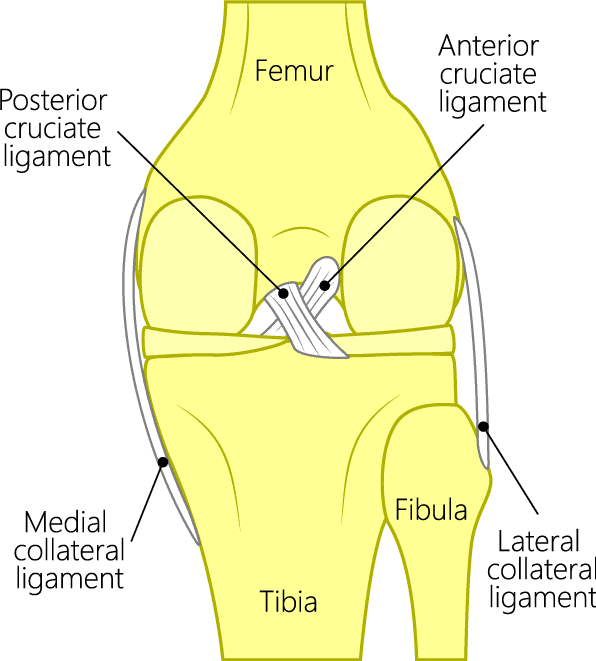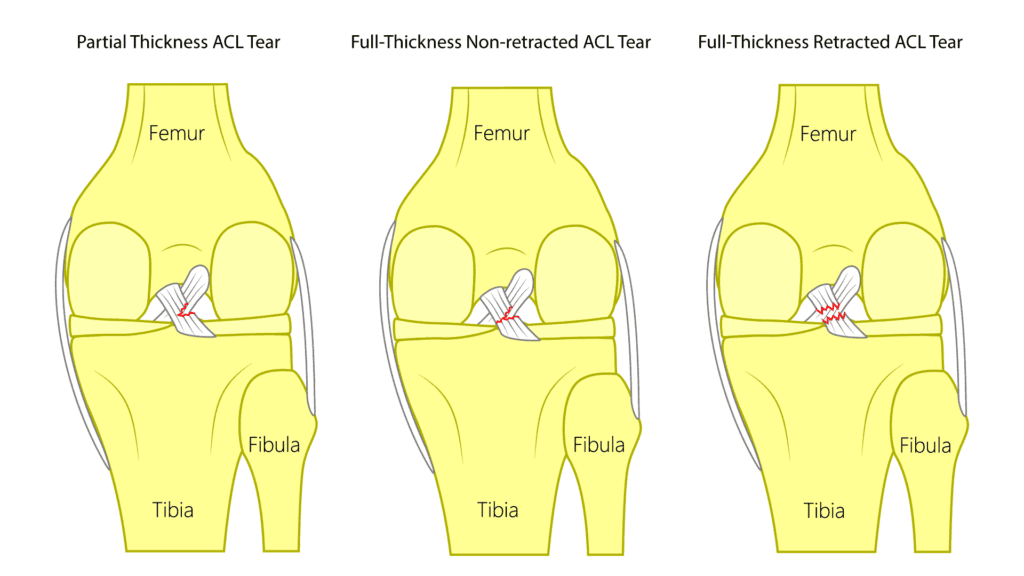ACL Tear Management Without Surgery In Ospina Medical – New York, NY
Do you have an MRI-confirmed partial or complete tear of the anterior cruciate ligament (ACL) and have been told surgery is your only option?
Perc-ACLR (percutaneous ACL repair) is a procedure that Regenexx created to treat full and partial anterior cruciate ligament tears non-surgically. ACL tears are one of the more common knee injuries treated by physicians in the licensed Regenexx network, including those at the Rehabilitation Medicine Center of New Jersey, NY. Many non-retracted full and partial tears may be addressed in all but the most severe cases.
ACL Tear Recovery Time Without Surgery
You have some important things to consider in making the best decision for your recovery, your return to sport or normal activity, and, ultimately, your long-term health. At Regenexx, the goal is to save your ACL, not replace it. The existing research and significant expertise support the possibility of successful natural healing of ACL injuries.
The Perc-ACLR is a highly precise X-ray-guided injection of your orthopedic bone marrow concentrate and can be completed in one day. It is far less invasive than surgery and generally requires far shorter recovery times. This procedure is available at Rehabilitation Medicine Center of New Jersey, NY.
| Perc-ACLR | Surgery | |
|---|---|---|
| Procedure Invasiveness | Much less | Much more |
| Return to Sports | 3 to 6 months | 1 year |
| Keep your ACL | Yes | NO |
| Recovery | Brace, much less extensive PT | Crutches, brace, extensive PT |
635 Madison Ave
Suite 1301
New York, NY 10022
Request an Appointment
Call to Schedule Schedule OnlineClinic Hours
| Sunday | Closed |
| Monday | 9AM–5PM |
| Tuesday | 9AM–5PM |
| Wednesday | 9AM–5PM |
| Thursday | 9AM–5PM |
| Friday | 9AM–5PM |
| Saturday | Closed |
How Does The Regenexx Approach Work?
At Regenexx, we invented a new approach to orthopedic care that we call Interventional Orthopedics. This minimally invasive alternative to ACL surgery uses ultrasound-guided technology to precisely inject your own bone marrow concentrate, which contains stem cells, directly where it’s needed in the joint.
The cells in your bone marrow concentrate work at the site of your injury to promote your body’s natural healing abilities to treat the tear and avoid surgery1
Regenexx For ACL Tears: Perc-ACLR
The procedure usually occurs over one day. First, your physician at the Rehabilitation Medicine Center of New Jersey, NY, will extract a small amount of bone marrow using precise imaging guidance and a specialized extraction technique unique to Regenexx.
Once the marrow is drawn and processed by a Regenexx lab technician, you will have time to relax before the reinjection of the harvested bone marrow concentrate into your ACL, done three to six hours later.
Specialized local anesthesia is applied before the reinjection using fluoroscopy (real-time imaging guidance). MRI imaging, along with X-ray contrast, is used to carefully map the torn ligament during the procedure, providing a “roadmap” for your physician to implant bone marrow concentrate into the damaged areas of the ligament.
After the procedure, your joint may be sore for one to three days, with discomfort typically decreasing within five to seven days. Most patients report observing improvement in ACL function within about a month and may resume light activities accordingly.
Am I a candidate?Before And After MRI Images
Take a look at the outcomes of patients who had a procedure with Regenexx protocol instead of ACL surgery.
The BEFORE shows a torn ACL. The area should be a dark band going diagonally, as shown on the AFTER.

FAQs

Knee joint anatomy showing ACL
There are two cruciate (meaning “cross-shape”) ligaments found inside your knee joint that work to stabilize it. They cross each other to form an X with the anterior cruciate ligament (ACL) in front and the posterior cruciate ligament (PCL) in the back. The ACL prevents the knee from sliding forward and the PCL from sliding backward.
ACL surgery is not typically urgent unless accompanied by extensive damage, severe instability, or intense pain. In most adults with joint stability, surgery may be delayed a month or two. For young athletes, a shorter waiting period may be advised to support a timely return to sports. Some individuals may benefit from physical therapy first. If this fails, procedures using Regenexx injectates, such as Perc-ACLR, available at the Rehabilitation Medicine Center of New Jersey, NY, may offer a nonsurgical alternative.
Research has also shown that ACL sprains and even complete ACL tears can regrow and heal on their own,2 particularly if interventional orthopedic procedures such as the Perc-ACLR procedure are utilized. These techniques do not require surgery and employ your body’s natural healing agents to repair your ACL injury. So, if your body can heal your ACL naturally, why would you choose surgery?
ACL sprains, tears, and ruptures are all essentially the same thing, and the terms are used interchangeably. Injured knee ligaments are all considered “sprains” and are graded on a severity scale.
- Grade 1 Sprains: The ligament is mildly damaged in a Grade 1 Sprain. It has been slightly stretched but is still able to help keep the knee joint stable.
- Grade 2 Sprains: A Grade 2 Sprain stretches or mildly tears the ligament to a point that the ACL becomes loose. This is also sometimes referred to as a partial tear of the ligament.
- Grade 3 Sprains: This type of sprain is most commonly referred to as a complete tear of the ligament. The ligament has been split into two pieces, and the knee joint is unstable.
An ACL rupture is another term often used to describe a tear. However, ruptures of the ACL are generally equated with complete full-thickness tears (Grade 3 Sprains) and are often associated with ligament deformity or full retraction.
Only about half of athletes regain full function after ACL reconstruction. The rest may have knee stability but not full biomechanical recovery. Seeking a second opinion is important, especially since misdiagnosis or unneeded surgery are possible.
Reported complications from surgery include:
- 17% experience anterior knee pain or pain while kneeling
- 5% to 29% experience graft failure and loss of stability
- Other risks: stiffness, infection, hardware issues, patellar complications
Youth ACL surgeries have shown even higher risk for complications like growth disturbance or rerupture. Procedures using Regenexx injectates at Rehabilitation Medicine Center of New Jersey, NY may offer a less invasive, joint-preserving alternative.
When it comes to ACL tears, there are numerous classifications and subtypes. In regenerative medicine, however, we define these tears by 3 types: partial thickness, full thickness non-retracted, and full thickness retracted. Both partial thickness and full-thickness, non-retracted tears can be treated with regenerative medicine utilizing the Regenexx knee Perc-ACL procedure to heal your tear without surgery. Full-thickness, retracted tears will likely require surgical repair to heal properly.
- Partial-Thickness ACL Tear:
A partial-thickness ACL tear is one that hasn’t torn completely through. It’s exactly as it sounds— on imaging, we would see that a portion of the ligament is still intact. - Full-Thickness Non-Retracted ACL Tear:
A full thickness nonretracted ACL tear is one that has torn all the way through; however, it hasn’t completely pulled apart or snapped back like a rubber band would. The ligament is certainly fully torn, but the pieces are still in place. - Full-Thickness Retracted ACL Tear:
A full thickness retracted ACL tear is one that has torn through, but in this case, the two pieces have pulled apart or maybe even snapped back like a rubber band.

Request an Appointment
References
1. Centeno C, Markle J, Dodson E, Stemper I, Williams C, Hyzy M, Ichim T, Freeman M. Symptomatic anterior cruciate ligament tears treated with percutaneous injection of autologous bone marrow concentrate and platelet products: a non-controlled registry study. J Transl Med. 2018 Sep 3;16(1):246. doi: 10.1186/s12967-018-1623-3. PMID: 30176875. PMID: 30176875. [Google Scholar]
2. Costa-Paz M, Ayerza MA, Tanoira I, Astoul J, Muscolo DL. Spontaneous healing in complete ACL ruptures: a clinical and MRI study. Clin Orthop Relat Res. 2012 Apr;470(4):979-85. doi: 10.1007/s11999-011-1933-8. PMID: 21643922. [Google Scholar]
3. Freedman KB, D’Amato MJ, Nedeff DD, Kaz A, Bach BR Jr. Arthroscopic anterior cruciate ligament reconstruction: a metaanalysis comparing patellar tendon and hamstring tendon autografts. Am J Sports Med. 2003 Jan-Feb;31(1):2-11. doi: 10.1177/03635465030310011501. PMID: 12531750. [Google Scholar]
4. Webster KE, Feller JA, Leigh WB, Richmond AK. Younger patients are at increased risk for graft rupture and contralateral injury after anterior cruciate ligament reconstruction. Am J Sports Med. 2014 Mar;42(3):641-7. doi: 10.1177/0363546513517540. Epub 2014 Jan 22. PMID: 24451111. [Google Scholar]
5. Burks RT, Friederichs MG, Fink B, Luker MG, West HS, Greis PE. Treatment of postoperative anterior cruciate ligament infections with graft removal and early reimplantation. Am J Sports Med. 2003 May-Jun;31(3):414-8. doi: 10.1177/03635465030310031501. PMID: 12750136. [Google Scholar]
6. Kovacic JJ in Complications of Anterior Cruciate Ligament Surgery, AAOS Monograph Series 2005. Accessed August 25, 2020.
7. Wong SE, Feeley BT, Pandya NK. Complications After Pediatric ACL Reconstruction: A Meta-analysis. J Pediatr Orthop. 2019 Sep;39(8):e566-e571. doi: 10.1097/BPO.0000000000001075. PMID: 31393290. [Google Scholar]
8. Frobell RB, Roos EM, Roos HP, Ranstam J, Lohmander LS. A randomized trial of treatment for acute anterior cruciate ligament tears. N Engl J Med. 2010 Jul 22;363(4):331-42. doi: 10.1056/NEJMoa0907797. Erratum in: N Engl J Med. 2010 Aug 26;363(9):893. PMID: 20660401. [Google Scholar]
